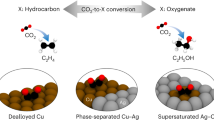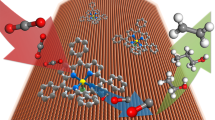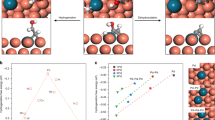Abstract
Engineering copper-based catalysts that favour high-value alcohols is desired in view of the energy density, ready transport and established use of these liquid fuels. In the design of catalysts, much progress has been made to target the C–C coupling step; whereas comparatively little effort has been expended to target post-C–C coupling reaction intermediates. Here we report a class of core–shell vacancy engineering catalysts that utilize sulfur atoms in the nanoparticle core and copper vacancies in the shell to achieve efficient electrochemical CO2 reduction to propanol and ethanol. These catalysts shift selectivity away from the competing ethylene reaction and towards liquid alcohols. We increase the alcohol-to-ethylene ratio more than sixfold compared with bare-copper nanoparticles, highlighting an alternative approach to electroproduce alcohols instead of alkenes. We achieve a C2+ alcohol production rate of 126 ± 5 mA cm−2 with a selectivity of 32 ± 1% Faradaic efficiency.
This is a preview of subscription content, access via your institution
Access options
Access Nature and 54 other Nature Portfolio journals
Get Nature+, our best-value online-access subscription
$29.99 / 30 days
cancel any time
Subscribe to this journal
Receive 12 digital issues and online access to articles
$119.00 per year
only $9.92 per issue
Buy this article
- Purchase on Springer Link
- Instant access to full article PDF
Prices may be subject to local taxes which are calculated during checkout





Similar content being viewed by others
Change history
17 June 2022
A Correction to this paper has been published: https://doi.org/10.1038/s41929-022-00812-4
References
Gao, S. et al. Partially oxidized atomic cobalt layers for carbon dioxide electroreduction to liquid fuel. Nature529, 68–71 (2016).
Asadi, M. et al. Nanostructured transition metal dichalcogenide electrocatalysts for CO2 reduction in ionic liquid. Science353, 467–470 (2016).
Liu, M. et al. Enhanced electrocatalytic CO2 reduction via field-induced reagent concentration. Nature537, 382–386 (2016).
Lin, S. et al. Covalent organic frameworks comprising cobalt porphyrins for catalytic CO2 reduction in water. Science349, 1208–1213 (2015).
Seh, Z. W. et al. Combining theory and experiment in electrocatalysis: insights into materials design. Science355, eaad4998 (2017).
Rogers, C. et al. Synergistic enhancement of electrocatalytic CO2 reduction with gold nanoparticles embedded in functional graphene nanoribbon composite electrodes. J. Am. Chem. Soc.139, 4052–4061 (2017).
Li, Y. et al. Structure-sensitive CO2 electroreduction to hydrocarbons on ultrathin 5-fold twinned copper nanowires. Nano Lett.17, 1312–1317 (2017).
Mistry, H. et al. Highly selective plasma-activated copper catalysts for carbon dioxide reduction to ethylene. Nat. Commun.7, 12123 (2016).
Saberi Safaei, T. et al. High-density nanosharp microstructures enable efficient CO2 electroreduction. Nano Lett.16, 7224–7228 (2016).
Lei, F. et al. Metallic tin quantum sheets confined in graphene toward high-efficiency carbon dioxide electroreduction. Nat. Commun.7, 12697 (2016).
Klinkova, A. et al. Rational design of efficient palladium catalysts for electroreduction of carbon dioxide to formate. ACS Catal.6, 8115–8120 (2016).
ZHU, Q.-G. et al. Cu2S on Cu foam as highly efficient electrocatalyst for reduction of CO2 to formic acid. Acta Phys. Chim. Sin.32, 261–266 (2016).
Zhu, Q. et al. Efficient reduction of CO2 into formic acid on a lead or tin electrode using an ionic liquid catholyte mixture. Angew. Chem. Int. Ed.55, 9012–9016 (2016).
Shinagawa, T., Larrazábal, G. O., Martín, A. J., Krumeich, F. & Perez-Ramirez, J. Sulfur-modified copper catalysts for the electrochemical reduction of carbon dioxide to formate. ACS Catal.8, 837–844 (2017).
Huang, Y., Deng, Y., Handoko, A. D., Goh, G. K. & Yeo, B. S. Rational design of sulfur‐doped copper catalysts for the selective electroreduction of carbon dioxide to formate. ChemSusChem11, 320–326 (2018).
Schouten, K. J. P., Calle‐Vallejo, F. & Koper, M. A step closer to the electrochemical production of liquid fuels. Angew. Chem. Int. Ed.53, 10858–10860 (2014).
Li, C. W. & Kanan, M. W. CO2 reduction at low overpotential on Cu electrodes resulting from the reduction of thick Cu2O films. J. Am. Chem. Soc.134, 7231–7234 (2012).
Loiudice, A. et al. Tailoring copper nanocrystals towards C2 products in electrochemical CO2 reduction. Angew. Chem. Int. Ed.55, 5789–5792 (2016).
Gawande, M. B. et al. Cu and Cu-based nanoparticles: synthesis and applications in catalysis. Chem. Rev.116, 3722–3811 (2016).
Hahn, C. et al. Engineering Cu surfaces for the electrocatalytic conversion of CO2: controlling selectivity toward oxygenates and hydrocarbons. Proc. Natl Acad. Sci. USA114, 5918–5923 (2017).
De Luna, P. et al. Catalyst electro-redeposition controls morphology and oxidation state for selective carbon dioxide reduction. Nat. Catal.1, 103–110 (2018).
Kortlever, R., Shen, J., Schouten, K. J. P., Calle-Vallejo, F. & Koper, M. T. Catalysts and reaction pathways for the electrochemical reduction of carbon dioxide. J. Phy. Chem. Lett.6, 4073–4082 (2015).
Adit Maark, T. & Nanda, B. R. K. Enhancing CO2 electroreduction by tailoring strain and ligand effects in bimetallic copper–rhodium and copper–nickel heterostructures. J. Phy. Chem. C121, 4496–4504 (2017).
van den Berg, R. et al. Structure sensitivity of Cu and CuZn catalysts relevant to industrial methanol synthesis. Nat. Commun.7, 13057 (2016).
Xiao, H., Goddard, W. A., Cheng, T., & Liu, Y. Cu metal embedded in oxidized matrix catalyst to promote CO2 activation and CO dimerization for electrochemical reduction of CO2. Proc. Natl Acad. Sci. USA114, 6685–6688 (2017).
Favaro, M. et al. Subsurface oxide plays a critical role in CO2 activation by Cu(111) surfaces to form chemisorbed CO2, the first step in reduction of CO2. Proc. Natl Acad. Sci. USA114, 6706–6711 (2017).
Kasatkin, I., Kurr, P., Kniep, B., Trunschke, A. & Schlögl, R. Role of lattice strain and defects in copper particles on the activity of Cu/ZnO/Al2O3 catalysts for methanol synthesis. Angew. Chem. Int. Ed.46, 7324–7327 (2007).
Liu, X. et al. Size‐controlled synthesis of Cu2‐xE (E = S, Se) nanocrystals with strong tunable near‐infrared localized surface plasmon resonance and high conductivity in thin films. Adv. Funct. Mater.23, 1256–1264 (2013).
Luther, J. M., Jain, P. K., Ewers, T. & Alivisatos, A. P. Localized surface plasmon resonances arising from free carriers in doped quantum dots. Nat. Mater.10, 361–366 (2011).
Hu, X. & Hirschmugl, C. Long-range metal-mediated interactions between S and CO on Cu(100). Phys. Rev. B72, 205439 (2005).
Montoya, J. H., Shi, C., Chan, K. & Nørskov, J. K. Theoretical insights into a CO dimerization mechanism in CO2 electroreduction. J. Phy. Chem. Lett.6, 2032–2037 (2015).
Montoya, J. H., Peterson, A. A. & Nørskov, J. K. Insights into C–C coupling in CO2 electroreduction on copper electrodes. ChemCatChem5, 737–742 (2013).
Schouten, K. J. P., Kwon, Y., van der Ham, C. J. M., Qin, Z. & Koper, M. T. M. A new mechanism for the selectivity to C1 and C2 species in the electrochemical reduction of carbon dioxide on copper electrodes. Chem. Sci.2, 1902–1909 (2011).
Calle‐Vallejo, F. & Koper, M. Theoretical considerations on the electroreduction of CO to C2species on Cu(100) electrodes. Angew. Chem. Int. Ed.52, 7282–7285 (2013).
Zhuang, T. T., Fan, F. J., Gong, M. & Yu, S. H. Cu1.94S nanocrystal seed mediated solution-phase growth of unique Cu2S-PbS heteronanostructures. Chem. Commun.48, 9762–9764 (2012).
Han, S. K., Gong, M., Yao, H. B., Wang, Z. M. & Yu, S. H. One‐pot controlled synthesis of hexagonal‐prismatic Cu1.94S‐ZnS, Cu1.94S‐ZnS‐Cu1.94S, and Cu1.94S‐ZnS‐Cu1.94S‐ZnS‐Cu1.94S heteronanostructures. Angew. Chem. Int. Ed.51, 6365–6368 (2012).
Zhuang, T.-T. et al. Integration of semiconducting sulfides for full-spectrum solar energy absorption and efficient charge separation. Angew. Chem. Int. Ed.55, 6396–6400 (2016).
Xie, Y. et al. Copper sulfide nanocrystals with tunable composition by reduction of covellite nanocrystals with Cu+ ions. J. Am. Chem. Soc.135, 17630–17637 (2013).
Kvashnina, K. et al. Electronic structure of complex copper systems probed by resonant inelastic X-ray scattering at Cu L3 edge. Phys. B404, 3559–3566 (2009).
Todd, E., Sherman, D. & Purton, J. Surface oxidation of chalcopyrite (CuFeS2) under ambient atmospheric and aqueous (pH 2–10) conditions: Cu, Fe L-and O K-edge X-ray spectroscopy. Geochim. Cosmochim. Acta67, 2137–2146 (2003).
Chakraverty, S., Mitra, S., Mandal, K., Nambissan, P. & Chattopadhyay, S. Positron annihilation studies of some anomalous features of Ni Fe2O4 nanocrystals grown in SiO2. Phys. Rev. B71, 024115 (2005).
Li, Z. et al. Dual vacancies: an effective strategy realizing synergistic optimization of thermoelectric property in BiCuSeO. J. Am. Chem. Soc.137, 6587–6593 (2015).
Gao, S. et al. Highly efficient and exceptionally durable CO2 photoreduction to methanol over freestanding defective single-unit-cell bismuth vanadate layers. J. Am. Chem. Soc.139, 3438–3445 (2017).
Ma, S., Luo, R., Moniri, S., Lan, Y. & Kenis, P. J. A. Efficient electrochemical flow system with improved anode for the conversion of CO2 to CO. J. Electrochem. Soc.161, F1124–F1131 (2014).
Ma, S., Lan, Y., Perez, G. M. J., Moniri, S. & Kenis, P. J. A. Silver supported on titania as an active catalyst for electrochemical carbon dioxide reduction. ChemSusChem7, 866–874 (2014).
Thang Dinh, C. et al. CO2 electroreduction to ethylene via hydroxide-mediated copper catalysis at an abrupt interface. Science360, 783–787 (2018).
Ma, S. et al. One-step electrosynthesis of ethylene and ethanol from CO2 in an alkaline electrolyzer. J. Power Sources301, 219–228 (2016).
Blöchl, P. E. Projector augmented-wave method. Phys. Rev. B50, 17953 (1994).
Kresse, G. & Joubert, D. From ultrasoft pseudopotentials to the projector augmented-wave method. Phys. Rev. B59, 1758 (1999).
Perdew, J. P., Burke, K. & Ernzerhof, M. Generalized gradient approximation made simple. Phys. Rev. Lett.77, 3865 (1996).
Muttaqien, F. et al. CO2 adsorption on the copper surfaces: van der Waals density functional and TPD studies. J. Phys. Chem. C147, 094702 (2017).
Kresse, G. & Furthmüller, J. Efficient iterative schemes for ab initio total-energy calculations using a plane-wave basis set. Phys. Rev. B54, 11169 (1996).
Wu, Y., Wadia, C., Ma, W., Sadtler, B. & Alivisatos, A. P. Synthesis and photovoltaic application of copper (I) sulfide nanocrystals. Nano Lett.8, 2551–2555 (2008).
Guo, H. et al. Shape-selective formation of monodisperse copper nanospheres and nanocubes via disproportionation reaction route and their optical properties. J. Phys. Chem. C118, 9801–9808 (2014).
Acknowledgements
This work was supported by TOTAL American Services, the Ontario Research Fund Research Excellence programme, the Natural Sciences and Engineering Research Council (NSERC) of Canada, the CIFAR Bio-Inspired Solar Energy programme and a University of Toronto Connaught grant. S.-H.Y. acknowledges funding from the National Natural Science Foundation of China (grant 21431006) and the Foundation for Innovative Research Groups of the National Natural Science Foundation of China (grant 21521001). All DFT computations were performed on the IBM BlueGene/Q supercomputer with support from the Southern Ontario Smart Computing Innovation Platform (SOSCIP). SOSCIP is funded by the Federal Economic Development Agency of Southern Ontario, the Province of Ontario, IBM Canada, Ontario Centres of Excellence, Mitacs and 15 Ontario academic member institutions. Z.L. acknowledges a scholarship from the China Scholarship Council (CSC) (201607090041). A.S. acknowledges Fonds de Recherche du Quebec—Nature et Technologies (FRQNT) for support in the form of a postdoctoral fellowship award. P.D.L. acknowledges NSERC for support in the form of a Canada Graduate Scholarship doctoral award. P.D.L. also wishes to acknowledge Y. Hu and the Canadian Light Source for assistance with X-ray absorption experiments. The authors thank A. Ip, Y. Wang, J. Fan, J. Li, C. Zou and Y. Zhou from the University of Toronto for fruitful discussions.
Author information
Authors and Affiliations
Contributions
E.H.S. and S.-H.Y. supervised the project. T.-T.Z. designed and carried out the experiments. Z.-Q.L. helped to investigate the performance measurements. A.S., F.C. and Y.M. carried out simulations. Y.L. helped to characterize the structure of catalyst. P.D.L. and R.Q.-B. performed the X-ray spectroscopy measurements. F.M. and B.-J.Y. carried out positron annihilation. All authors discussed the results and assisted during manuscript preparation.
Corresponding authors
Ethics declarations
Competing interests
The authors declare no competing interests.
Additional information
Publisher’s note: Springer Nature remains neutral with regard to jurisdictional claims in published maps and institutional affiliations.
Supplementary information
Supplementary Information
Supplementary Methods; Supplementary Figures 1–20; Supplementary Tables 1–11; Supplementary References
Rights and permissions
About this article
Cite this article
Zhuang, TT., Liang, ZQ., Seifitokaldani, A. et al. Steering post-C–C coupling selectivity enables high efficiency electroreduction of carbon dioxide to multi-carbon alcohols. Nat Catal 1, 421–428 (2018). https://doi.org/10.1038/s41929-018-0084-7
Received:
Accepted:
Published:
Issue Date:
DOI: https://doi.org/10.1038/s41929-018-0084-7
This article is cited by
-
Defect-induced triple synergistic modulation in copper for superior electrochemical ammonia production across broad nitrate concentrations
Nature Communications (2024)
-
Directing CO2 electroreduction pathways for selective C2 product formation using single-site doped copper catalysts
Nature Chemical Engineering (2024)
-
A surface strategy boosting the ethylene selectivity for CO2 reduction and in situ mechanistic insights
Nature Communications (2024)
-
Dynamics of bulk and surface oxide evolution in copper foams for electrochemical CO2 reduction
Communications Chemistry (2024)
-
Hierarchical Bi/S-modified Cu/brass mesh used as structured highly performance catalyst for CO2 electroreduction to formate
Nano Research (2024)



